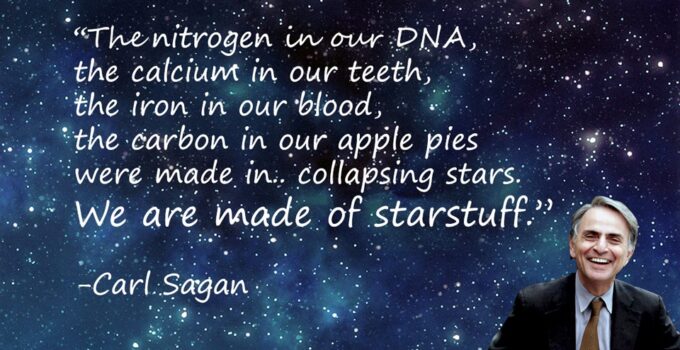Introduction
One of the biggest questions that has been asked for many millennia (and perhaps even before by past intelligent human species such as the neanderthals long before homo sapiens came up with written language) is how the world that we know came to be. Before we talk about humans & other animals/plants in future blog entry, it is important to talk of the elements that our bodies are composed of, such as carbon.
The notion of atoms is old, but the actual experimentation of them is fairly new beginning with chemistry. Early on, humans did not know that everything was composed of atoms. The ideas of atoms themselves were theorized & originated in ancient Greek & Indian philosophy, but technology was not yet there to see these atoms until almost another 2400+ years. It was, of course, with the first microscopes that humanity was able to study atoms/elements starting in mid-1800’s (much later for more in-depth analysis). [1]
Once these atoms could directly be experimented on, it was found out that different types of atoms (elements) gave off distinct characteristics. For instance, different elements had different boiling points, and all had different number of protons and neutrons (basic stuff taught in elementary school nowadays). There are also isotopes, but that is for a future blog entry.
The finding of all these elements led to another question: how could Earth have all these complex elements, such as carbon and oxygen? Later on, these same elements were found on nearby planets and most recently on distant planets in distant galaxies by studying the electromagnetic spectrum (remember, every element gives off distinct wavelength and this can be measured). This led to bigger question: were the elements always present throughout the universe since the big-bang? If not, where did they originate?
Star Cycle & Complex Elements
The truth is such complex elements beyond Hydrogen did not originate from thin air and were not always present. Hydrogen is the most basic element with only one proton and contained in 75% of the known universe. As for more complex elements, we have very strong evidence that links them to the cores of distant large massive stars.
Before I explain the quote “we’re made of star stuff”, I will quickly explain star cycle of massive stars and how they end up containing the complex atoms such as Carbon.
Source: Planetfacts.org
Very large stars have stronger gravity since they contain more mass, which in turn leads to much higher pressures and much higher temperatures. These higher temperatures and pressure leads to more instability. More than that, large stars have larger volume that needs to burn through more fuel. That excess temperature/pressure/volume, in turn, means they have to burn through their cores much quicker than smaller stars like our Sun.
Now every time the massive star used nuclear fusion for the hydrogen, it leaves helium behind. For a high-mass star that has lots of hydrogen and a massive appetite, the star will burn through its hydrogen quickly. While that happens, helium builds up. Once the star has more helium than hydrogen, it starts fusing helium — remember, this does NOT mean that the star will no longer have hydrogen left. It simply shifts from one elements to other once there is more helium than hydrogen.
Helium fusion leads to Carbon fusion. Carbon leads to oxygen then onto neon, magnesium, silicon, all the way up to iron. Iron is the absolute last element that can fuse since it is very massive.
Once massive iron builds up, the outward pressure builds up TREMENDOUSLY to the point that gravity can no longer keep it in check. Once that happens, the entire star explodes into what we call supernova. Powerful supernovas can be seen in the night sky with the naked eye when they happen. The supernova is so powerful that it forces more complex elements beyond iron to form.
Now we come to the dead star and the quote. That massive star once contained all of those elements and now those complex atoms were blown across extremely large areas by the outward explosion. While that is going, other star systems are forming throughout the galaxy with their own gravity. That gravity pulls in some of those complex atoms from that one star. Remember, it is not just one supernova but thousands going on in vast star systems that contribute atoms to the newly-forming star system.
Since smaller stars like our Sun cannot burn through beyond helium (less mass => weaker gravity => lower temperature => lower pressure), they need to pull in these elements that were sent flying across by the nearby supernova.
When stars form, they very often end up with planets, which is where some of those complex elements end up. That is where we get these complex elements like Carbon that are contained within our bodies and also where Carl Sagan’s quote comes into play. Our atoms that we rely on, such as carbon, come from these distant extremely large stars.[2]
Conclusion
Circle of life is also circle of the universe. Humans, at the atomic level, are nothing more than a conglomerate of atoms grouped into complex molecules. These molecules form the various organs in our bodies with their distinct jobs (lungs’ job is to provide oxygen to the blood, kidney to purify blood, liver to provide nutrients to the blood from the digested food, etc). Before I get hopelessly off-topic, I will focus more on complex life in future blog entries.
That, to me, is the essence of life itself. There is no magic involved in how our bodies work or how these atoms are on planet Earth. Everything has an explanation of some sort that simply needs to be found if we look for it.
When you consider everything, life is truly spectacular and what is even greater is that we are all connected. When we die, we never truly die because our atoms might one day end up in a future living organism. We are all immortal, for we never truly die. That, I believe, is the ultimate inspiration that is to be for all eternity.
I would like to end with this video by the Astrophysicist Neil DeGrasse Tyson, who explains the quote in more elegant way that I could never do:
1 – http://en.wikipedia.org/wiki/Atomism
2 – All of this information I learned & acquired from astrophysics classes I took for fun at Rutgers University (I was an Information Technology major). The wording is based on my understanding and I referred to my own notes from class. The only citation is the class itself, but you can find more in-depth things online. The star cycle is well understood and well-documented through telescope observations and our understanding of physics as it applies on the grand scale. Remember, you don’t have to see a star’s entire life to see what it does as that would be impossible, but you study similar-sized and similar mass stars at different points in their life cycle (pretty easy to find a star’s size and mass using math & HR diagram – google it). From that, you can acquire all you need.
Next week I want to blog about time. I was going to blog about that today, but I realized I need to think & reflect further upon that. For next time, what is time?




